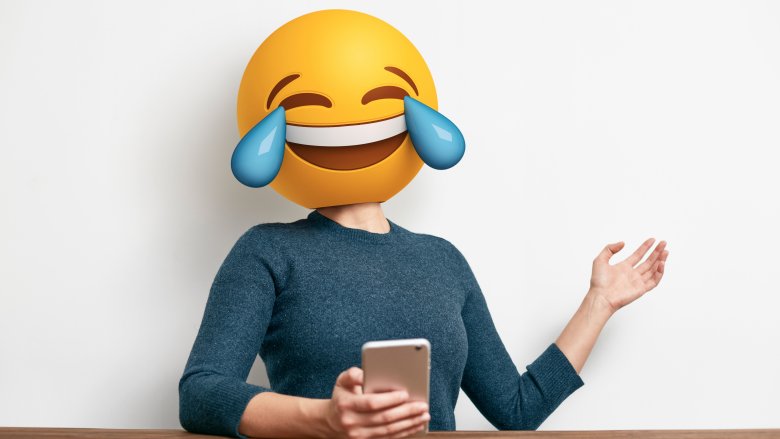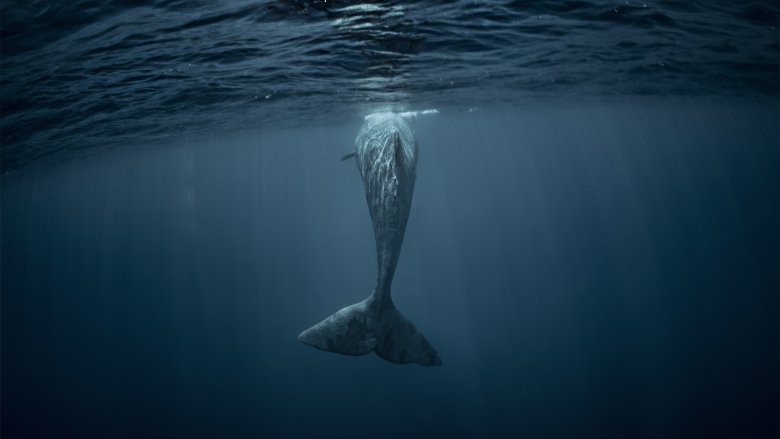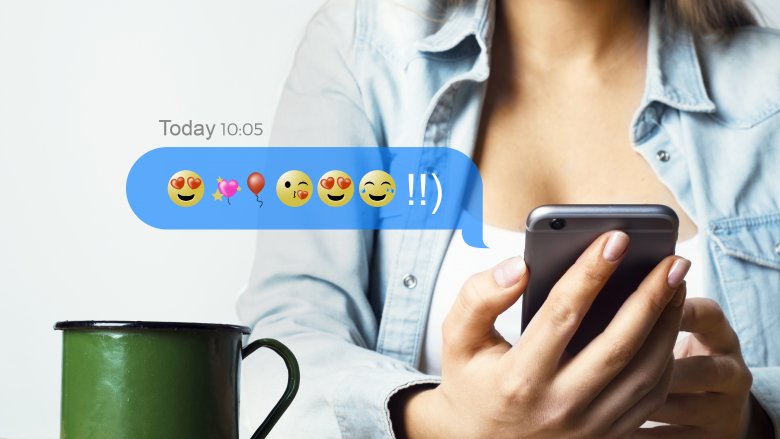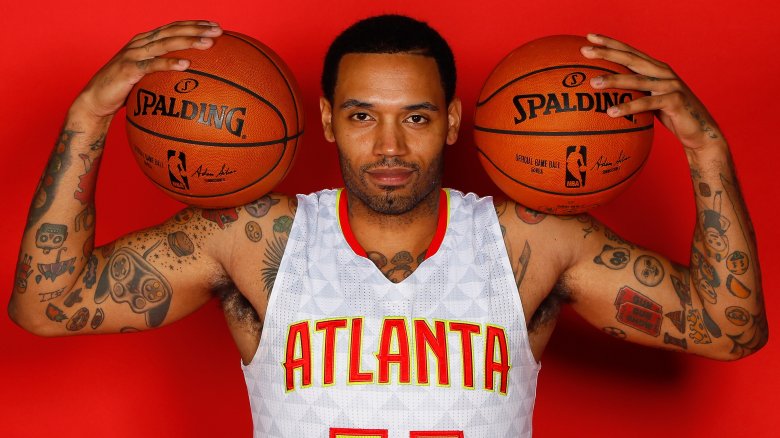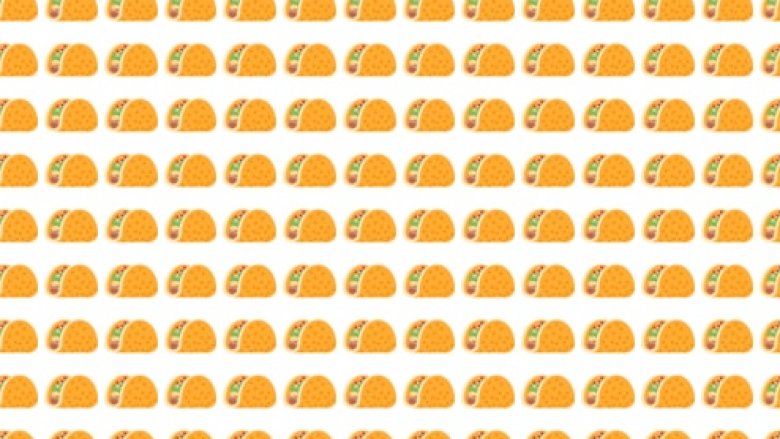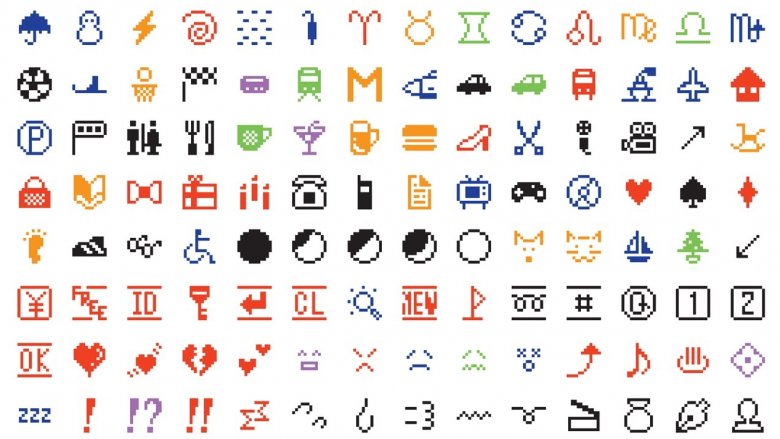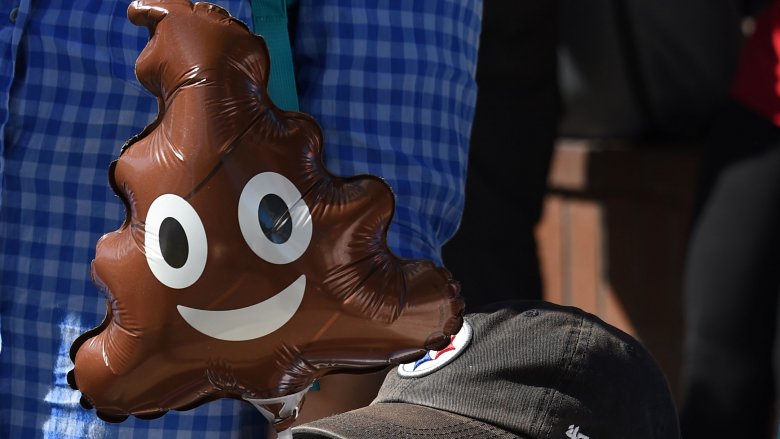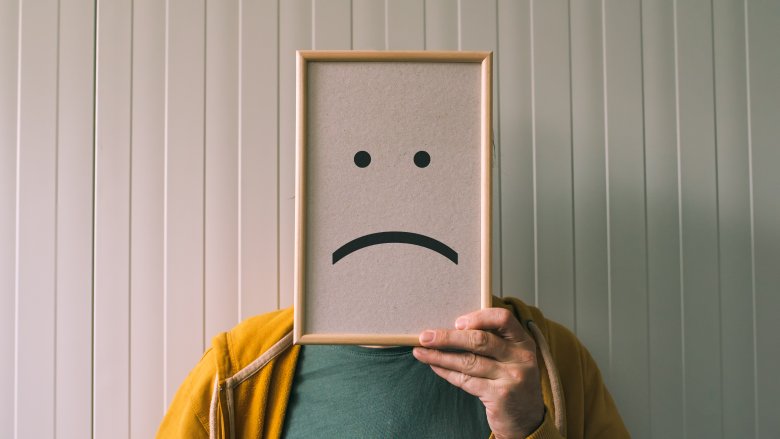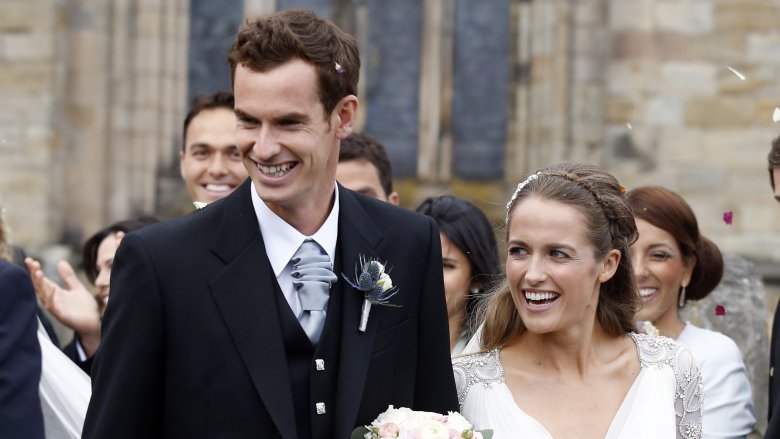The Untold Truth Of Emojis
Emojis have come a long way since their primitive beginnings as emoticons. What started out as simple joke markers have since exploded into a crucial means of communication, as well as a very, very bad animated feature film. These days, emojis are simply inescapable, but how much do you really know about the little ideograms? Here's the untold truth of emojis.
Emoji Dick
As a true classic of the American Renaissance, Herman Melville's Moby-Dick has been translated into numerous languages and is available the whole world over. And now, thanks to Eyebeam's Fred Benenson, anyone can read the novel in the universal language of emoji.
In 2009, Benenson launched a Kickstarter campaign to produce copies of the hefty 19th-century novel written only using emojis. Naturally, one can't help but wonder why. In an interview with The New Yorker, Benenson answered that question, telling the magazine that he was "interested in the phenomenon of how our language, communications, and culture are influenced by digital technology" and wanted to "confront a lot of our shared anxieties about the future of human expression." The results are, indeed, strange.
As to why he chose Melville's Great American Novel, Benenson needed a work in the public domain that was large enough to truly demonstrate the scale of Amazon's Mechanical Turk, a service that pays humans small sums for repetitive tasks that can't be automated. After testing a couple chapters, he realized that Melville's book about a "huge, seemingly insurmountable challenge, told using metaphors and stylized language" was indeed a match made in heaven.
What would actually be helpful is translating James Joyce's Ulysses into emojis since no one can understand the English version.
Emoji-only social networking
There once was a social network with no words and no spam. Just emojis.
Created by a pair of British internet personalities named Matt Gray and Tom Scott, the emoji-only social network — called Emojli — both started and ended as a joke, according to Time. Users could each register their own unique user name (written in emojis), and communication was based entirely around little ideograms of eggplants, monkeys, whales, emotional faces, and the like. Emojli didn't last long, however. According to the creators, the social networking application was never actually intended to be a startup, and very few people actually used it, despite being downloaded over 60,000 times. "To keep Emojli running ... we would have had to spend a decent amount of money," they announced, "and it just wasn't worth it for the joke."
App developer Clicksco totally thought the joke was worth it, however, and took it upon themselves to create Emojli's replacement, Emojicate — a social networking app which allows users to create eight-emoji-long statuses, while also featuring the ability to add your friends' faces into the "sentences," which is ultimately about as fun as it sounds. The app is was available on both iOS and Android, but reviews were less than stellar and it's now off the Play Store, so you may want to stick with simply sprinkling in some emojis on Facebook and Twitter.
Emoji tattoos
You say you love emojis — but are you hardcore enough to get some tattooed on your body?
NBA baller Mike Scott is: he sports plenty of emoji tattoos. He has emoji lips tattooed on his neck — which once prompted NBA legend and fan favorite Vince Carter to ask, mid-game, what's that's all about — as well as, among others, the "pair of Playboy bunny-looking girls dancing side-by-side" emoji. In an interview with Mashable's Sam Laird, Scott said he just likes them. "I guess you could say I got my girls on one side and then my mistress on the other side." Classy!
Scott's not the only celebrity with a permanent love for emojis. Canadian rapper Drake has the prayer-hands emoji tattooed on his arm, next to a numeral "6" representing Toronto. Painfully, American pop star, actor, and media migraine Miley Cyrus got a sad-kitty emoji tattooed on the inside of her bottom lip. Ouch! Not everyone is convinced it's real, but Cyrus is known for her wild tattoos. "People get tattoos of the most f––––d up s––t," she told Rolling Stone. Yeah, they really do.
The great Taco Bell emoji petition
"We did it" — three magic words for taco lovers everywhere.
On October 21, 2015, the taco emoji was born, thanks to everyone's favorite fourth-meal fast food haven, Taco Bell. When fans realized there was no taco emoji, the Mexican-themed restaurant created a petition on Change.org, asking, "Why do pizza and hamburger lovers get an emoji but taco lovers don't? Here's a better question: why do we need four different types of mailboxes? Or 25 different types of clocks? Or a VCR tape and floppy disk emoji? No one even uses those things anymore." Over the next seven months, 32,741 supporters added their support to the not-so-life-changing petition.
The Unicode Consortium ultimately approved the release of the taco emoji, though, to be fair, the taco emoji was already in consideration before Taco bell hopped on the emoji publicity train. Either way, Taco Bell was happy to tweet its celebration by posting 140 consecutive taco emojis. Thank heaven we can count on Taco Bell to tackle the issues that really matter. (Although, seriously, they do actually help people sometimes.)
Emojis are officially modern art
In October 2016, the Museum of Modern Art in New York acquired Japanese mobile phone operator NTT DoCoMo's original set of 176 12x12 pixel emojis for its permanent collection, calling them "masterpieces of design" which "planted the seeds for the explosive growth of a new visual language," while officially making the tiny pictures praiseworthy works of art.
And praise the emojis MoMA has. The museum's senior curator for architecture and design, Paola Antonelli, told NPR that it's difficult to overstate the importance of NTT DoCoMo's original creations from 1999, noting how pervasive they are in our culture. He's right, of course. What would we possibly do without pixelated depictions of waning moons and pints of lager?
Not all emojis are welcome at MoMA, however — so don't get too excited about seeing tacos and hot dogs proudly displayed alongside Frank Lloyd Wright anytime soon. When asked about adding today's emojis to the museum's collection, Antonelli replied, "Maybe one day, and it depends on which ones." Right now, the focus is on the first digital cave paintings of the prehistoric cellphone days.
Poop and ice cream look alike, by design
If you're an iPhone user, you might have noticed that the ice cream emoji and the smiling pile of poop emoji look awfully similar. It isn't just you.
According to Willem Van Lancker, a former intern responsible for the creation of 400 of the original 500 iPhone emojis, your incredibly keen observation is valid. In December 2012, Joe Coscarelli of New York Magazine interviewed Lancker via text and popped the one pressing question on everyone's mind: "Why does [ice cream emoji] look so much like [smiling poop emoji]?" Lancker responded by, more or less, confirming what we all already knew. "Some design elements may have been reused between them ... [wink face emoji]."
May have? Definitely were. Just add the cone to the smiling pile of feces and you have (smiling) chocolate ice cream. In fact, Peter Miller already did that, and the two fit together perfectly — prompting some to wonder whether it's even poop in the first place. Some prefer to think of it merely as a coneless pile of soft-serve chocolate ice cream. However, common sense will tell you it's poop, as will The Emoji Movie, which is as close as we're going to get to an official canon.
The creator of emoticons hates emojis
Emoticons are so last decade. These days, if you're not down with emojis, you're way behind the times.
One person who is definitely not down is Carnegie Mellon University's notable computer scientist Scott Fahlman. On September 19, 1982, at 11:44 a.m., Fahlman changed the course of digital history by proposing a simple solution to an ongoing problem with an online university bulletin board — namely, that jokes were regularly being interpreted as serious statements and vice versa. His solution: "I propose that [sic] the following character sequence for joke markers: :-) Read it sideways. Actually, it is probably more economical to mark things that are NOT jokes, given current trends. For this, use :-(" And so the happy and sad emoticons were born — at least, until someone else provides evidence of an earlier usage. (We're looking at you, Abraham Lincoln.)
Like a Dr. Frankenstein disappointed with the actions of his monster, Fahlman doesn't like how his creation has evolved. "I think [modern emojis] are ugly," Fahlman told The Independent, "and they ruin the challenge of trying to come up with a clever way to express emotions using standard keyboard characters." However, he admits that his ill feelings may stem from merely from the fact that he created the other kind. :...(
More emojis = more sex?
Every 10 years, the always-eagerly-awaited United States Census collects pertinent data about almost everyone living within the country's borders. It paints a fairly accurate picture of the nation's demographics, but it doesn't always ask the important questions, like "How often do you use emojis?" and "How often do you have sex?"
According to Match.com's 2014 annual Singles in America survey — which polled 5,675 single, non-Match-using Americans — sex and emojis go hand in hand. The study was led, in part, by Rutgers University biological anthropologist Dr. Helen Fisher, who told Time that "54 percent of emoji users had sex in 2014 compared to 31 percent of singles who did not." Is that really so hard to believe? It's not easy to accurately gauge tone and intent over text, as we all know. With the majority of 21st-century singles communicating with some form of text messaging, throwing in the occasional emoji helps add a little flair to flirtatious conversation.
But wait, there's more. Emoji users don't simply have more sex. According to Fisher, "they go on more dates and they are two times more likely to want to get married." If you want to get flushed in the face a little more often (for life or just for a fling), you might try improving your emoji game.
Andy Murray shared his wedding itinerary using only emojis
Only moments before Andy Murray tied the knot with his wife Kim Sears, the Wimbledon-winning tennis star took to Twitter to share the itinerary of the couple's special day with the rest of the world. Except, he did it using only emojis.
As is the beauty with forgoing words for a much simpler form of language, everyone is free to interpret the tweet as literally or as figuratively as they like. Hello Magazine read the string of emojis blandly, pointing out the weather and the literal string of events. That's one way of looking at it.
Of course, you could also say that Murray started the day by laugh-crying at the weather, at his wife's beauty preparations, and at his wife in her wedding dress. Then they both drove to a church in their regular clothes, danced like ballerinas down the aisle, prayed for wealth, signed autographs, played the piano, and then got their grub on at a karaoke party full of dancing Playboy bunnies, ice cream, donuts, and boatloads of booze — all before passing out and sleeping it off. You had to be there.
Finland became the first country with its own emojis
When you think of Finland, do you think of steamy saunas, indestructible Nokia phones, and long-haired heavy-metal headbangers? Of course you do.
In November 2015, Finland became the self-proclaimed "first country in the world to publish its own set of country themed emojis." The set of 56 unique emojis are definitely weird and extremely Finnish. For example, there's the "Lost hopes" emoji, featuring two people with the Finnish flag painted on their faces, one excited and one dejected. Why, you ask? "Finland is notorious for its lack of success in the Eurovision Song Contest," thisisFINLAND describes. "Each time we wait for a win but get zero points. So to get back at them we entered a band of monsters in 2006 — and won."
There's also the "Meanwhile in Finland" emoji of a man enjoying below-freezing weather in a tank top, as well as a "Baby in a box" emoji, since every expectant mother in the Scandinavian country receives a pretty sweet care package/mini-crib of baby swag. Of course, there are also naked people in the sauna, woolly socks, headbangers, bears, and anything else you can think of that is stereotypically Finnish — including the original Santa Claus, reindeer, and happiness coming in the form of defeating Sweden in hockey.
'The Emoji Movie' was really bad
Just because emojis are both culturally pervasive and crucial to communication doesn't mean you can just throw up a family-friendly film about the Unicode faces and expect people to like it, as Sony Pictures just found out.
The Emoji Movie just barely escaped joining Rotten Tomatoes' 0 percent club. Right now, it's sitting at 6 percent, thanks to glowing reviews which call its plotline "meh," its execution both "boldly bad" and "boldly boring," and everything else about it "zestless" and "pointless." Those are the kindest of the bunch. Others, such as Ed Potton from Times (UK), comment on the obvious fact that the film doesn't even try, writing that "not only does this film hate its very subject matter, it's also the most hideous example of product placement in cinematic history."
Any doubts that the film was merely a cash grab can be laid to rest by the very fact that Sony put forth a review embargo — something we commonly see in happen in the video game industry — on the film, forbidding reviewers from publishing their reviews until the day the movie came out. This strategy may have helped the film rake in $24.5 million over its opening weekend. Thumbs down emoji from reviewers; thumbs up emoji from wallet-holders.
